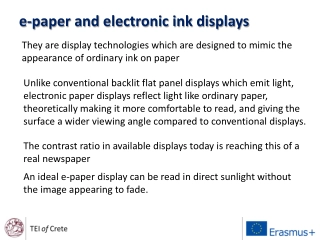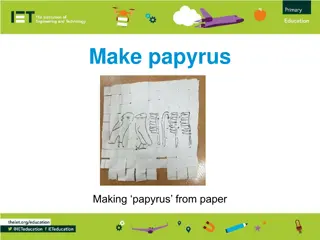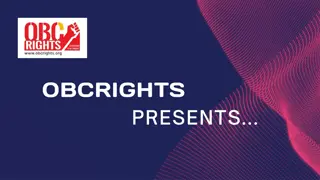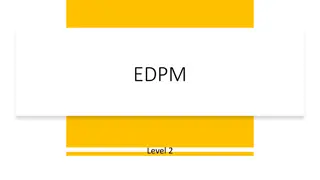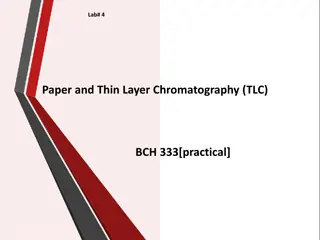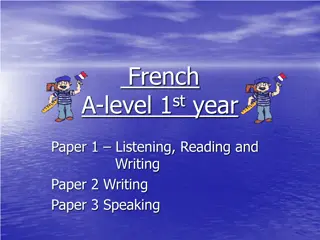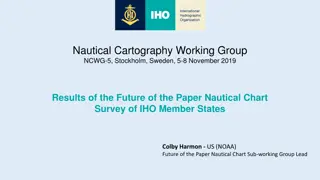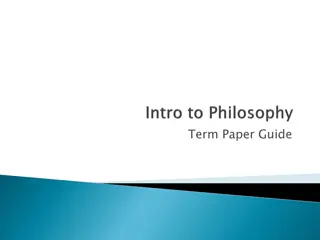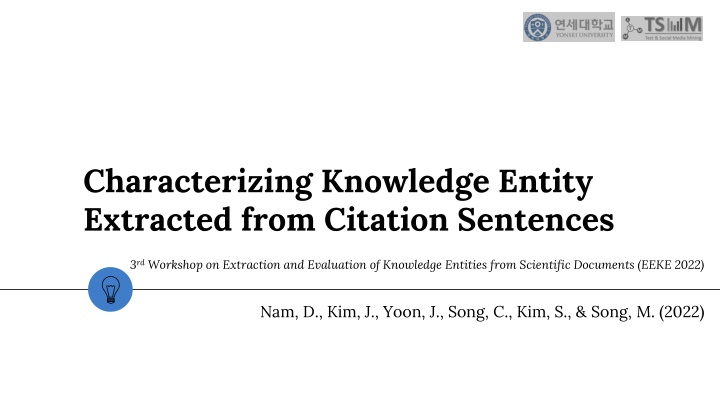
Characterizing Knowledge Entities: Extracting Insights from Citation Sentences
Explore the significance of knowledge entities in scientific literature analysis through a unique citation sentence-based approach. Investigate the construction of cooccurrence networks and uncover new aspects in the opioid domain structure. Methodology involves data collection, parsing, and matching cited authors with citation sentences.
Download Presentation

Please find below an Image/Link to download the presentation.
The content on the website is provided AS IS for your information and personal use only. It may not be sold, licensed, or shared on other websites without obtaining consent from the author. If you encounter any issues during the download, it is possible that the publisher has removed the file from their server.
You are allowed to download the files provided on this website for personal or commercial use, subject to the condition that they are used lawfully. All files are the property of their respective owners.
The content on the website is provided AS IS for your information and personal use only. It may not be sold, licensed, or shared on other websites without obtaining consent from the author.
E N D
Presentation Transcript
Characterizing Knowledge Entity Extracted from Citation Sentences 3rdWorkshop on Extraction and Evaluation of Knowledge Entities from Scientific Documents (EEKE 2022) Nam, D., Kim, J., Yoon, J., Song, C., Kim, S., & Song, M. (2022)
Table of Contents 1. Introduction 4. Conclusion 2. Methodology 5. References 3. Results 2
Introduction Exponential increase of scientific publication is being consistently observed. The importance of knowledge entities as a means to extract meaningful and structured knowledge from such mass literature is also growing. 3
Introduction Entitymetrics [1] is an approach enabling entity level analysis on scientific literature and related researches are being actively conducted since its proposal in 2013. Unlike conventional entitymetrics methods that utilized title/abstract or full-text, we propose a novel citation sentence-based approach. Ding et al. (2013) 4
Introduction Citation sentences include both the citing and cited author s intention for the corresponding contents. In the perspective of the citing author, he or she takes advantage of the citation sentence in order to obtain credibility for their research. For the cited author, citation sentence is a channel of recognition receiving acknowledgment from other researchers for their established research findings. 5
Introduction In this context, analysis of citation sentence can provide insights, which reflects both citing and cited author s interest. This study investigates three different research questions: 1. How can we construct a citation sentence-based cooccurrence network by using entitymetrics? 2. What is the key difference between our suggested networks and a conventionally built cooccurrence network? 3. What kind of new aspects can we find from the knowledge structure of opioid domain by utilizing citation sentence-based networks? 6
Methodology Figure 1: The Overall Schematic Research Workflow for the Proposed Methods 7
Methodology Data Collection & Parsing Collected the total full-text research papers that were published until March 2022 by using opioid as the search query in PubMed Central (PMC). Total of 118,808 papers collected. Based on this, we identified citation sentences that referred to other research publications. In this process, the cited authors were also matched with the citation sentences. 8
Methodology Bio-Entity Extraction (NER) To extract bio-entities from the collected citation sentences, PKDE4J [13] was employed for named entity recognition (NER). To obtain comprehensive findings from the collected dataset, we used a total of five biomedical entity dictionaries, which are: - Drug - Disease - Compound - Protein - Treatment 9
Methodology Network Construction This study formed two citation sentence-based networks in accordance with differently set cooccurrence window. One is built upon entity cooccurrence within same citation sentences, whereas the other is formed based on entity cooccurrence within author information that is included in the citation sentence. Since the former method considers direct cooccurrence within the citation sentences, it is defined as a direct citation sentence network (DCS network). The latter approach is defined as an indirect citation sentence network (ICS network) because it captures cooccurrence beyond sentence-based occurrence instance by generating indirect pairs employing author information. 10
Figure 2: Cooccurrence Network Construction Process for the Direct and Indirect Citation Sentence Network. Newly captured entity pairs are highlighted (red box) 11
Methodology Figure 3: Citation sentence-based author-entity bipartite network converted into an entity-entity network 12
Methodology Network Comparison Analysis To demonstrate our proposed method s usefulness, we compared DCS and ICS network with a conventionally built full-text cooccurrence network in two different aspects. First, we compared network features (e.g., density, average path length, average clustering coefficient, and modularity) of our suggested networks with the traditional full- text network. Then, we explored the top-20 bio-entity pairs derived from the cooccurrence results from the DCS and the ICS network and compared them with the traditional network. 13
Results Based on different power-law distribution studies [21][22][23], we excluded bio-entities and bio- entity cooccurrence pairs that showed unusually low-frequencies (frequency less than 10) in order to obtain reasonable results by getting rid of non-informative data. Also, a total of 75 bio-entities that were in the top-100 entity frequency list were excluded due to their ambiguous and overly general characteristics. DCS network consists of 6,105 bio-entities and 45,087 links, whereas ICS network contains 13,525 bio-entities and 1,831,917 links. For comparison, a cooccurrence network was formed based on full-text data, which consists of 13,292 bio-entities and 144,800 links. 14
Results Network Features Network Features Conventional method DCS Network ICS Network 0.00164 0.00242 0.0201 Density 3.351 3.434 2.336 APL* 0.601 0.612 0.918 ACC** 0.407 0.455 0.148 Modularity * Average Path Length ** Average Clustering Coefficient 15 15
Results Network Features Table 2: Top-10 bio-entities for each cluster in direct citation sentence network (Cluster 1: pain management-related, Cluster 2: tumor- & disease-related, Cluster 3: anesthetic- & analgesic- related, Cluster 4: psychological disorder- & reward system- related) Table 3: Top-10 bio-entities for each cluster in indirect citation sentence network (Cluster 1: psychological disorder- & reward system-related, Cluster 2: pain disorder-related, Cluster 3: tumor- & disease-related) Table 1: Top-10 bio-entities for each cluster in full-text network (Cluster 1: anesthetic and analgesic related, Cluster 2: tumor and disease related, Cluster 3: psychological disorder and reward system related) chronic pain; neuropathic; pain postoperative pain; analgesics; pain management; pain relief; quality of life; hyperalgesia; paracetamol; painful Cluster 1 morphine; anesthesia; fentanyl; infusion; saline; sedation; propofol; ketamine; analgesics; postoperative pain SUD; addiction; dopamine; withdrawal; mental health; reward; amp; perception; emotional; psychological Cluster 1 Cluster 1 tumor; liver; calcium; mrna; mitochondrial; proliferation; oxidative stress; dna; nmda; il-6 Cluster 2 chronic pain; morphine; neuropathic pain; anesthesia; analgesics; adverse effects; quality of life; pain relief; persistent; postoperative pain tumor; liver; glucose; mrna; dna; hypertension; hcv; obesity; rna; il-6 Cluster 2 Cluster 2 morphine; anesthesia; sedation; fentanyl; ketamine; infusion; propofol; epidural; dexmedetomidine; adverse effects Cluster 3 substance use disorder; withdrawal; chronic pain; addiction; dopamine; cocaine; amp; neuropathic pain; methadone; mental health tumor; calcium; gaba; liver; mrna; obesity; proliferation; progression; toxicity; oxidative stress Cluster 3 Cluster 3 SUD; dopamine; addiction; withdrawal; cocaine; reward; amp; mental health; gaba; methadone Cluster 4 16
Results Bio-Entity Pair Analysis Proposed Networks vs. Full-Text Network ICS Network vs. Full-Text Entity 1 SUD mental health chronic pain SUD dopamine withdrawal withdrawal addiction abuse chronic pain analgesics morphine analgesics dopamine SUD SUD addiction dopamine chronic pain SUD DCS Network vs. Full-Text Entity 1 SUD mental health methadone morphine dopamine anesthesia cbd glucose heroin hyperalgesia postoperative pain withdrawal gabapentin propofol naloxone morphine anterior hip amphetamine SUD Entity 2 addiction SUD neuropathic pain cocaine reward SUD addiction reward SUD morphine morphine fentanyl chronic pain addiction heroin reward cocaine SUD pain management relapse Freq 8684 6480 6080 5814 5363 4819 4507 4448 4246 4227 4210 4177 4159 4135 4120 4110 4108 4105 4002 3930 Entity 2 addiction SUD buprenorphine fentanyl reward propofol thc insulin cocaine allodynia pain management morphine pregabalin sedation overdose oxycodone posterior fracture cocaine cocaine Freq 1993 1992 1989 1942 1544 1482 1290 1206 1203 1172 1162 1146 1132 1126 1119 1107 1092 1052 1050 1048 Table 4: Top-20 bio-entity pair in the direct citation sentence network (bolded pairs represent exclusive pairs compared with the full-text network) Table 5: Top-20 bio-entity pair in the indirect citation sentence network (bolded pairs represent exclusive pairs compared with the full-text network) 17
Results Bio-Entity Pair Analysis DCS Network vs. ICS Network DCS Network ICS Network Entity 1 SUD mental health methadone morphine dopamine anesthesia cbd glucose heroin hyperalgesia postoperative pain withdrawal gabapentin propofol naloxone morphine anterior hip amphetamine SUD Entity 2 addiction SUD buprenorphine fentanyl reward propofol thc insulin cocaine allodynia pain management morphine pregabalin sedation overdose oxycodone posterior fracture cocaine cocaine Entity 1 SUD mental health chronic pain SUD dopamine withdrawal withdrawal addiction abuse chronic pain analgesics morphine analgesics dopamine SUD SUD addiction dopamine chronic pain SUD Entity 2 addiction SUD neuropathic pain cocaine reward SUD addiction reward SUD morphine morphine fentanyl chronic pain addiction heroin reward cocaine SUD pain management relapse Table 6: Top-20 bio-entity pair comparison between DCS and ICS network (bolded pairs represent exclusive pairs compared with each other) 18
Conclusion RQ1: How can we construct a citation sentence-based cooccurrence network by using entitymetrics? DCS network & ICS network RQ2: What is the key difference between our suggested networks and a conventionally built cooccurrence network? Network feature comparison RQ3: What kind of new aspects can we find from the knowledge structure of opioid domain by utilizing citation sentence-based networks? Bio-entity cooccurrence pair analysis 19
Conclusion It was found that a citation sentence-based approach can expand the base of entitymetrics. By constructing the DCS and ICS network, it was clear that each of these novel networks provided different insights for the exploration of knowledge entity and knowledge structure. While the ICS network tends to provide much more general and broader bio-entity pairs, the DCS network offers much more specific and specialized bio-entity pairs. These methods can support the need for the use of citation sentences in future entitymetrics studies when a more in-depth knowledge structure analysis is needed. 20
References [20] Kate Flemming MSc, RN, 2010. The Use of Morphine to Treat Cancer-Related Pain: A Synthesis of Quantitative and Qualitative Research. Journal of Pain and Symptom https://doi.org/10.1016/j.jpainsymman.2009.05.014 [21] Garrett Enten, Mina A. Shenouda, David Samuels, Naomi Fowler, Maha Balouch, and Enrico Camporesi, 2019. A Retrospective Analysis of the Safety and Efficacy of Opioid-free Anesthesia versus Opioid Anesthesia for General Cesarean Section. Cureus 11, 9 (Sep, 2019), e5725. DOI: https://doi.org/10.7759/cureus.5725 [22] Andrew Kolodny, David T. Courtwright, Catherine S. Hwang, Peter Kreiner, John L. Eadie, Thomas W. Clark, and G. Caleb Alexander, 2015. The Prescription Opioid and Heroin Crisis: A Public Health Approach to an Epidemic of Addiction. Annual review of public health 36, (Mar, 2015), 559-574. DOI: https://doi.org/10.1146/annurev-publhealth-031914-122957 [23] Steven T. Piantadosi, 2014. Zipf s word frequency law in natural language: A critical review and future directions. Psychonomic bulletin & review 21, 5 (Mar, 2014), 1112-1130. DOI: https://doi.org/10.3758/s13423-014-0585-6 [24] lvaro Corral, Gemma Boleda, and Ramon Ferrer-i-Cancho, 2015. Zipf s law for word frequencies: word forms versus lemmas in long texts. PloS one 10, 7 (Jul, 2015), e0129031. DOI: https://doi.org/10.1371/journal.pone.0129031 [25] Sta a Milojevi , 2010. Power law distributions in information science: Making the case for logarithmic binning. Journal of the American Society for Information Science and https://doi.org/10.1371/journal.pone.0129031 [26] M. E. J. Newman, 2004. Fast algorithm for detecting community structure in networks. Physical review E 69, 6 (Jun, 2004), 066133. DOI: https://doi.org/10.1103/PhysRevE.69.066133 [27] Lauri Nummenmaa, Tiina Saanijoki, Lauri Tuominen, Jussi Hirvonen, Jetro J. Tuulari, Pirjo Nuutila, and Kari Kalliokoski, 2018. -opioid receptor system mediates reward processing in humans. Nature communications 9, 1 (Apr, 2018), 1-7. DOI: https://doi.org/10.1038/s41467-018-03848-y [28] Julie Le Merrer, J r me A. J. Becker, Katia Befort, and Brigitte L. Kieffer, 2009. Reward processing by the opioid system in the brain. Physiological reviews, (Oct, 2009). DOI: https://doi.org/10.1152/physrev.00005.2009 [29] Troels S Jensen and Nanna B Finnerup, 2014. Allodynia and hyperalgesia in neuropathic pain: clinical manifestations and mechanisms. The Lancet Neurology 13, 9 (Sep, 2014), 924-935. DOI: https://doi.org/10.1016/S1474-4422(14)70102-4 [30] Marion Lee, Sanford Silverman, Hans Hansen, Vikram Patel, and Laxmaiah Manchikanti, 2011. A comprehensive review of opioid-induced hyperalgesia. Pain Physician 14, 2 (Jan, 2011), 145-161. [31] Maurice H. Zissen, Guohua Zhang, Alvin McKelvy, John T. Propst, Joan J. Kendig, and Sarah M. Sweitzer, 2007. Tolerance, opioid-induced allodynia and withdrawal associated allodynia in infant and young rats. Neuroscience 144, 1 (Jan, 2007), 247- 262. DOI: https://doi.org/10.1016/j.neuroscience.2006.08.078 [32] Tara Gomes, David N. Juurlink, Tony Antoniou, Muhammad M. Mamdani, J. Michael Paterson, and Wim van den Brink, 2017. Tolerance, opioid-induced allodynia and withdrawal associated allodynia in infant and young rats. PLoS Med 14, 10 (Oct, 2017), 247-262. e1002396. DOI: https://doi.org/10.1371/journal.pmed.1002396 [33] Emma Morrison, Euan A. Sandilands, and David J. Webb, 2017. Gabapentin and pregabalin: Do the benefits outweigh the harms? The Journal of the Royal College of Physicians https://doi.org/10.4997/JRCPE.2017.402 [34] Preeti Manandhar , Bridin Patricia Murnion , Natasha L. Grimsey, Mark Connor, and Marina Santiago, 2021. Do gabapentin or pregabalin directly modulate the receptor? PeerJ 9, (Apr, 2021), e11175. DOI: https://doi.org/10.7717/peerj.11175 [35] Sinead McNamara, Siobhan Stokes, R. Kilduff, and Aine Shine, 2015. Pregabalin Abuse amongst Opioid Substitution Treatment Patients. Ir Med J 108, 10 (Nov, 2015), 309-310. DOI: https://doi.org/10.7717/peerj.11175 [36] European Monitoring Centre for Drugs and Drug Addiction and Kate ina ka upov , 2014 The levels of use of opioids, amphetamines and cocaine and associated levels of harm : summary of scientific evidence. Publications Office. DOI: https://data.europa.eu/doi/10.2810/49447 [37] Wilson M. Compton, Christopher M. Jones, and Grant T. Baldwin, 2016. Relationship between nonmedical prescription- opioid use and heroin use. New England Journal https://doi.org/10.1056/NEJMra1508490 [38] Howard L. Fields, 2011. The Doctor's Dilemma: Opiate Analgesics and Chronic Pain. Neuron 69, 4 (Feb, 2011), 591-594. DOI: https://doi.org/10.1016/j.neuron.2011.02.001Conference Short Name:WOODSTOCK 18 [1] Ying Ding, Min Song, Jia Han, Qi Yu, Erjia Yan, Lili Lin, and Tamy Chambers, 2013. Entitymetrics: Measuring the impact of entities. PloS one 8, 8 (Aug, 2013), e71416. DOI: https://doi.org/10.1371/journal.pone.0071416 Allan Peter Davis, Thomas C. Wiegers, Phoebe M. Roberts, Benjamin L. King, Jean M. Lay, Kelley Lennon-Hopkins, Daniela Sciaky, Robin Johnson, Heather Keating, Nigel Greene, Robert Hernandez, Kevin J. McConnell, Ahmed E. Enayetallah, and Carolyn J. Mattingly, 2013. A CTD Pfizer collaboration: manual curation of 88 Xuelian Pan, Erjia Yan, Ming Cui, and Weina Hua, 2018. Examining the usage, citation, and diffusion patterns of bibliometric mapping software: A comparative study of three tools. Journal of informetrics 12, 2 (May, 2018), 481-493. DOI: https://doi.org/10.1016/j.joi.2018.03.005 Yoo Kyung Jeong, Qing Xie, Erjia Yan, and Min Song, 2020. Examining drug and side effect relation using author entity pair bipartitenetworks. Journal of informetrics 14, 1 (Feb, 2020), 100999. DOI: https://doi.org/10.1016/j.joi.2019.100999 Yongjun Zhu, Min Song, and Erjia Yan, 2016. Identifying liver cancer and its relations with diseases, drugs, and genes: A literature-basedapproach. PLoS One 11, 5 (May, 2016), e0156091. DOI: https://doi.org/10.1371/journal.pone.0156091 Bahaa Ibrahim, 2021. Statistical methods used in Arabic journals of library and information science. Scientometrics 126, 5 (Mar, 2021), 4383-4416. DOI: https://doi.org/10.1007/s11192-021-03913-2 Yuzhuo Wang and Chengzhi Zhang. 2018. Using Full-Text of Research Articles to Analyze Academic Impact of Algorithms. In: Chowdhury, G., McLeod, J., Gillet, V., Willett, P. (eds) Transforming Digital Worlds. iConference 2018. Lecture Notes in Computer Science, vol 10766. Springer, Cham. DOI: https://doi.org/10.1007/978-3-319-78105-1_43 Yuzhuo, Wang and Chengzhi Zhang, 2020. Using the full-text content of academic articles to identify and evaluate algorithm entities in the domain of natural language processing. Journal of Informetrics 14, 4 (Nov, 2020), 101091. DOI: https://doi.org/10.1016/j.joi.2020.101091 Mengnan Zhao, Erjia Yan, and Kai Li, 2017. Data set mentions and citations: A content analysis of full-text publications. Journal of the Association for Information Science and Technology 69, 1 (Sep, 2018), 32-46. DOI: https://doi.org/10.1002/asi.23919 [10] Yuzhuo Wang, Chengzhi Zhang, and Kai Li, 2022. A review on method entities in the academic literature: extraction, evaluation, and application. Scientometrics, (Mar, 2022), 1-42. DOI: https://doi.org/10.1007/s11192-022-04332-7 [11] Yanhua Lv, Ying Ding, Min Song, and Zhiguang Duan, 2018. Topology-driven trend analysis for drug discovery. Journal of Informetrics 12, 3 (Aug, 2018), 893-905. DOI: https://doi.org/10.1016/j.joi.2018.07.007 [12] Xin Li, Justin F. Rousseau, Ying Ding, Min Song, and Wei Lu, 2020. Understanding drug repurposing from the perspective of biomedical entities and their evolution: Bibliographic research using aspirin. MIR medical informatics 8, 6 (Jun, 2020), e16739. DOI: https://doi.org/10.2196/16739 [13] Nora D. Volkow, Emily B. Jones, Emily B. Einstein, and Eric M. Wargo, 2019, Prevention and treatment of opioid misuse and addiction: A review. JAMA Psychiatry, 76, 2 (Feb, 2019) 208 216. DOI: https://doi.org/10.1001/jamapsychiatry.2018.3126 [14] Waleed M. Sweileh, Naser Y. Shraim, Sa'ed H. Zyoud and Samah W. Al-Jabi, 2016, Worldwide research productivity on tramadol: A bibliometric analysis. SpringerPlus, 5, 1108 (Jul, 2016) DOI: https://doi.org/10.1186/s40064-016-2801-5 [15] Min Song, Won Chul Kim, Dahee Lee, Go Eun Heo, and Keun Young Kang, 2015. PKDE4J: Entity and relation extraction for public knowledge discovery. Journal of biomedical https://doi.org/10.1016/j.jbi.2015.08.008 [16] Guoyong Mao, and Ning Zhang, 2013. Analysis of Average Shortest-Path Length of Scale-Free Network. Journal of Applied Mathematics 2013, (Jul, 2013). DOI: https://doi.org/10.1155/2013/865643 [17] Stanley Wasserman and Katherine Faust. 1994. Social network analysis: Methods and applications (1st. ed.). Cambridge University Press, Cambridge, England. [18] Vincent D Blondel, Jean-Loup Guillaume, Renaud Lambiotte, and Etienne Lefebvre, 2008. Fast unfolding of communities in large networks. Journal of statistical mechanics: theory https://doi.org/10.1088/1742-5468/2008/10/P10008 [19] M. E. J. Newman, 2004. Analysis of weighted networks. Physical review E 70, 5 (Nov, 2004), 056131. DOI: https://doi.org/10.1103/PhysRevE.70.056131 Management 39, 1 (Jan, 2010), 139-154. DOI: [2] [3] [4] [5] [6] Technology 61, 12 (Nov, 2010), 2417-2425. DOI: [7] [8] [9] of Edinburgh 47, 4 (Dec, 2017), 310-313. DOI: informatics 57, (Oct, 2015), 320-332. DOI: and experiment 2008, 10 (Oct, 2008), P10008. DOI: of Medicine 374, 2 (Jan, 2016), 154-163. DOI:
Thank You 22

